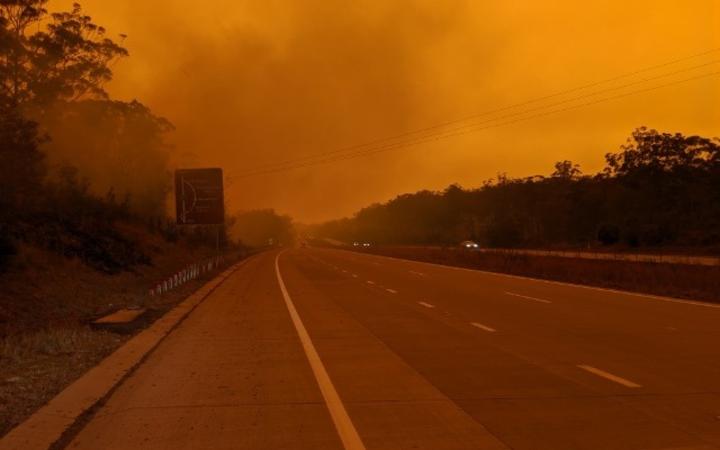Worse than Delhi: air quality
lowest in world in part of
NSW
16
November 2019
Seven
days of smoke and ash from the New South Wales bushfire emergency
have taken a toll on Port Macquarie, which on Friday experienced the
world's lowest air quality rating.

A
file shot of fires around the Port Macquarie area earlier this
week. Photo: Facebook / Live Traffic NSW
The
State Government told parents to collect their children from schools
in the Mid North Coast city as conditions deteriorated.
At
4pm, the Environment Department gave Port Macquarie an Air Quality
Index (AQI) of 1739, warning that all residents should stay inside as
much as possible.
Port
Macquarie's deteriorating air quality meant it was rated
significantly worse than pollution hotspots like New Delhi and
Beijing.
At
Nambucca, about 100 kilometres north of Port Macquarie, striking
images of beaches covered in bushfire ash showed the toll the blazes
had taken on the environment.
Senior
lifeguard James Turnham saw the ash washing up on the beaches.
"The
beaches have a dusting of ash and the high-tide lines have black ash
and burnt leaves, but the water is mostly clear," he said.
An
Environment Department spokesperson said smoke from bushfires and
increased dust because of the drought were among the factors leading
to the poor air quality.
Air
pollution becomes "hazardous" when the rating is over 200.
The AQI is a scale used by governments and organisations to inform
the public how polluted their local area is.
Earlier
this week, NSW Premier Gladys Berejiklian declared a "state of
emergency" due to the bushfires, which have so far killed four
people and destroyed more than 300 homes.
Jason
Koenig, who lives at Kew near Port Macquarie, and his wife were asked
to pick up their three young children from school due to the air
quality.
"The
schools are doing their best to minimise the smoke but it is still
very dark and hazy," he said.
"It's
difficult to breathe, so a lot of the kids would be having breathing
difficulties."
Further
north there were widespread delays and cancellations at Coffs Harbour
airport.
There
have been increases in the number of hospital presentations for
asthma and breathing problems in areas worst affected by the NSW
bushfire emergency, prompting a renewed call for people to take
precautions when there was smoke in the air.
Emergency
Department data shows that hospitals on the Mid North Coast, where
fires were at their worst, have had 68 presentations to hospital
emergency departments for asthma or breathing problems over the past
week - almost double the usual number.
Man arrested for lighting bushfire
A
51-year-old man suspected of lighting an out-of-control bushfire
which has triggered an emergency warning in the NSW Northern
Tablelands has been arrested.
The
fast-moving blaze at Guyra Road in Ebor, northeast of Armidale was
burning across more than 2000ha on Friday afternoon as it spreads
towards the Ebor township.
The
man was being held at Armidale Police Station.
Dozens
of bushfires are continuing to burn across northern New South Wales
and southeast Queensland following a week of destruction in which
four people died.
A
million hectares of land have been razed by the wildfires raging over
eastern parts of both states.
The
weather bureau is warning that the strong winds and lightning strikes
forecast are increasing the threat to communities in the border
region between Queensland and New South Wales.
-
ABC
"With the current rate of depletion we could be in a tricky situation in a couple of years," she said, adding that this was the worst drought in NSW on record.
https://edition.cnn.com/2019/11/15/australia/australia-fires-sydney-water-intl-hnk-scli/index.html?fbclid=IwAR3XWYgXBytJuI4bw-83KiG0ItXwkCCUCQCKRCPTuL_A0oziitBMlcRHNgQ
Since
June, the greater Sydney area in New South Wales state has been under
level 1 water restrictions, which limit water usage in filling pools
or running hoses unattended. It is the first time the restrictions
have been implemented since 2003, during a drought that lasted until
2009.
If
dam levels drop just a few percentage points in greater Sydney,
residents could face even harsher water restrictions.
Dams
in greater Sydney are currently at 46.6% capacity. According to the
NSW water authority, they are on track to hit 40% -- which means
level 2 water restrictions would be imposed by next February or
March.
Melinda
Pavey, the state's water minister, told 7News she didn't want to
"scare people unnecessarily," but said the government was
considering level 2 restrictions.
Level
2 restrictions would further limit the use of water in daily
operations -- for example, only allowing watering gardens a few days
a week instead of every day.
"With the current rate of depletion we could be in a tricky situation in a couple of years," she said, adding that this was the worst drought in NSW on record.
https://edition.cnn.com/2019/11/15/australia/australia-fires-sydney-water-intl-hnk-scli/index.html?fbclid=IwAR3XWYgXBytJuI4bw-83KiG0ItXwkCCUCQCKRCPTuL_A0oziitBMlcRHNgQ




No comments:
Post a Comment
Note: only a member of this blog may post a comment.